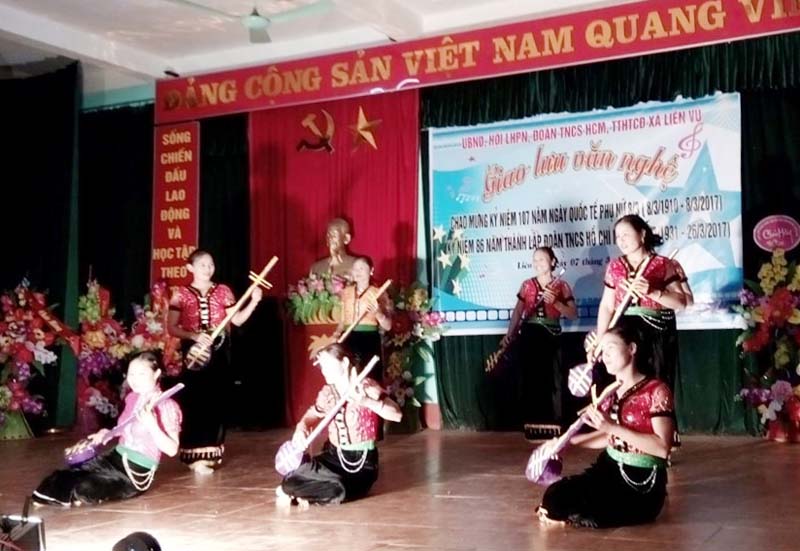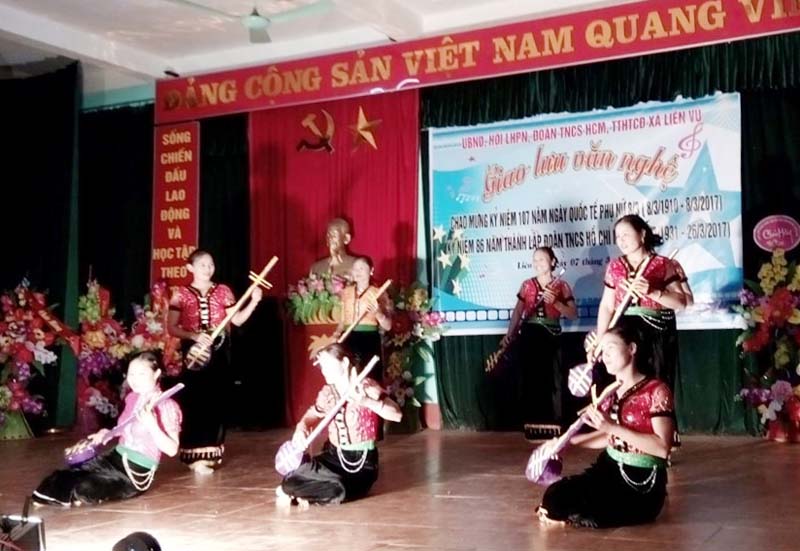
(HBO)- Currently, 100% of hamlets and streets in Lien Vu commune (Lac Son district) have a performance and gong teams. The commune has nine art cultural clubs, which are established under the decision of the Lien Vu People's Committee. It also has one cultural club named "The Youth preserves the national cultural identity" established by the Youth Union of the commune.

The performance teams of Lien Vu commune (Lac Son) perform to serve the
needs of enjoying the poeple’s spiritual culture.
The performance and the gong teams were also established in a lot of
schools in the district. Each performing
arts team has from fifteen to twenty main people. They have great passion for
singing, dancing and traditional musical instruments. The art clubs and teams
operate in the form of socialization. Activities of mass clubs and teams are
regularly maintained at village and hamlet cultural houses and integrated into
regular meetings of associations and unions. Each club and art team has its own
strengths and most of the performances are traditionally national songs and
dances. Each performance team has been invested with a mandolin and the commune
gave a set of gong to th high and the secondary schools on the occasion of the
opening ceremony of 2018 – 2019 school year for training and performance.
Ms. Bui Thi Nhien, a member of Huong Que Club, Beo Village says that Huong
Que Club was established in 2013, so far, all club members really like singing
and national musical instruments. They have the same desire to preserve and promote
the national cultural identity. A special point creating the vitality of the
movement is the passion and enthusiasm of the amateurs artists and actors for
the preservation of the traditional cultural values and the reception of the
people through performances. Besides the training and performances, the club
members also actively guide and teach folk songs and gong songs to their
children in the neighborhood. Thereby, it not only helps the performance teams
with the opportunity to perform, exchange and learn more experiences but it
also helps them with preservation and promotion of the national cultural
identity.
With an increasingly vibrant and widespread emulation movement aimed at building cultured residential areas and cultured families, Yen Thuy District has been making steady progress toward improving both the material and spiritual well-being of its people, while fostering a civilized, prosperous, beautiful, and progressive community.
Once lacking recreational spaces and community facilities, Residential Group 2 in Quynh Lam Ward (Hoa Binh City) has recently received attention for the construction of a new, spacious, and fully equipped cultural house. The project followed the model of state support combined with public contributions in both labor and funding.
The "All people unite to build cultural life" movement, which has been effectively integrated with Kim Boi district’s socio-economic development goals, is fostering a lively spirit of emulation across local residential areas, hamlets, villages, public agencies, and enterprises. In addition, through the initiative, traditional cultural values are being preserved and promoted, while community solidarity and mutual support in poverty reduction and economic development are being strengthened.
A working delegation of the Hoa Binh provincial People’s Committee led by its Permanent Vice Chairman Nguyen Van Toan on June 11 inspected the progress of a project to build the Mo Muong Cultural Heritage Conservation Space linked to tourism services in Hop Phong commune, Cao Phong district.
Born and growing in the heroic land of Muong Dong, Dinh Thi Kieu Dung, a resident in Bo town of Kim Boi district, in her childhood was nurtured by the sweet lullabies of her grandmother and mother. These melodies deeply imprinted on her soul, becoming an inseparable part of her love for her ethnic group's culture. For over 20 years, this love for her hometown has driven Dung to research, collect, and pass down the cultural values of the Muong people to future generations.
In the final days of May, the Ethnic Art Troupe of Hoa Binh Province organized performances to serve the people in remote, mountainous, and particularly disadvantaged areas within the province. These were not just ordinary artistic shows, but they were the meaningful journeys aimed at spreading cultural values, enhancing the spiritual life of the people and contributing to the preservation of ethnic minority cultural identities.



